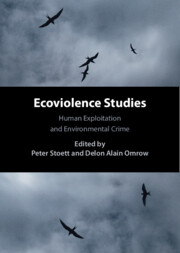Book contents
- Ecoviolence Studies
- Ecoviolence Studies
- Copyright page
- Contents
- Contributors
- Foreword
- Foreword
- Preface and Acknowledgments
- 1 Ecoviolence Studies and Human Security
- 2 The Links between Human Trafficking and Wildlife Trafficking
- 3 Preventing a Secondary Disaster: How Emergency Management Agencies Can Prepare and Respond to Disaster-Linked Exploitation
- 4 Ecoviolence at Sea
- 5 There Will Be Blood: The Return of the Frontier Logic in Guyana and Hyper-Exploitation in the Mining Sector
- 6 Artisanal Gold Mining in Uganda: Towards Formalization as Remediation of Dignity and Rights
- 7 Searching for Shelter in the Climate Crisis Era: Ecocide and Migration
- 8 Climate Change, Violence and Ecocide
- 9 Sea of Cortez Region: Crime and Ecosystem Crossroads
- 10 Minority Languages as Collateral Damage in the Climate Crisis: The Incidental Result of Ecoviolence on Y Gymraeg/Welsh Language
- Index
- References
7 - Searching for Shelter in the Climate Crisis Era: Ecocide and Migration
Published online by Cambridge University Press: 13 February 2025
- Ecoviolence Studies
- Ecoviolence Studies
- Copyright page
- Contents
- Contributors
- Foreword
- Foreword
- Preface and Acknowledgments
- 1 Ecoviolence Studies and Human Security
- 2 The Links between Human Trafficking and Wildlife Trafficking
- 3 Preventing a Secondary Disaster: How Emergency Management Agencies Can Prepare and Respond to Disaster-Linked Exploitation
- 4 Ecoviolence at Sea
- 5 There Will Be Blood: The Return of the Frontier Logic in Guyana and Hyper-Exploitation in the Mining Sector
- 6 Artisanal Gold Mining in Uganda: Towards Formalization as Remediation of Dignity and Rights
- 7 Searching for Shelter in the Climate Crisis Era: Ecocide and Migration
- 8 Climate Change, Violence and Ecocide
- 9 Sea of Cortez Region: Crime and Ecosystem Crossroads
- 10 Minority Languages as Collateral Damage in the Climate Crisis: The Incidental Result of Ecoviolence on Y Gymraeg/Welsh Language
- Index
- References
Summary
This chapter analyzes one of the most visible consequences of ecocide: eco-migration. The international criminal justice system does not include detrimental effects of ecocide or of social harm resulting in forced migration flows as a genuine crime capable of being prosecuted. However, a recent landmark United Nations Human Rights Committee decision claims that people should not be returned to their place of origin if climate change appears to constitute a threat. The United Nations Refugee Agency also welcomes such a pioneering ruling since it lays the ground for potentially effective international protection. This work examines the contemporary loophole regarding eco-displacements and ecocide and clamors for both legal and criminological international conceptualisation at ensuring the rights of eco-migrants, considering the future number of eco-migrants is unforeseeable.
Keywords
- Type
- Chapter
- Information
- Ecoviolence StudiesHuman Exploitation and Environmental Crime, pp. 121 - 138Publisher: Cambridge University PressPrint publication year: 2025

